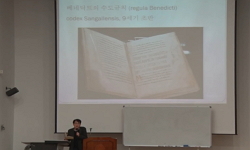이 논문은 1930년대 시어가 어떻게 선택되고 배치되었는가를 통해 식민지 조선어의 위상을 살펴보고자 하였다. 조선의 근대화와 민족적 전통성의 확립은 1930년대 식민지 조선 문학의 주요한 ...
http://chineseinput.net/에서 pinyin(병음)방식으로 중국어를 변환할 수 있습니다.
변환된 중국어를 복사하여 사용하시면 됩니다.
- 中文 을 입력하시려면 zhongwen을 입력하시고 space를누르시면됩니다.
- 北京 을 입력하시려면 beijing을 입력하시고 space를 누르시면 됩니다.
1930년대 詩에 나타난 植民地 朝鮮語의 位相 : 金起林·鄭芝溶·白石을 中心으로 = (The)Prestige of Korean Language during 1930s Japanese Colonial Period : Focusing on Poems by Kim Gi-rim, Jeong Ji-yong and Paek Seok
한글로보기https://www.riss.kr/link?id=T11559800
- 저자
-
발행사항
서울 : 고려대학교 대학원, 2008
- 학위논문사항
-
발행연도
2008
-
작성언어
한국어
-
주제어
1930년대 ; 시어 ; 조선어 ; 문명 ; 교양 ; 전통 ; 민족 ; 고백 ; 물질성 ; 1930s ; poetic word ; Joseon language ; modern civilization ; cultural language ; symbolism ; a cultural heritage ; national language ; traditionalism ; transcendental subject ; confession ; materialization
-
발행국(도시)
서울
-
형태사항
195 p. : 삽도 ; 26 cm.
-
일반주기명
지도교수: 최동호
참고문헌 : p. 178-191 - DOI식별코드
- 소장기관
-
0
상세조회 -
0
다운로드
부가정보
국문 초록 (Abstract)
이 논문은 1930년대 시어가 어떻게 선택되고 배치되었는가를 통해 식민지 조선어의 위상을 살펴보고자 하였다. 조선의 근대화와 민족적 전통성의 확립은 1930년대 식민지 조선 문학의 주요한 과제였다. “근대 문명의 번역과 표상성의 획득”, “과거의 호명과 역사성의 기입”, “조선어의 개성화와 시어의 물질성”은 1930년대 시어 형성의 세 가지 주요 국면이라고 할 수 있다. 조선의 근대화 과정 속에서 1930년대 문학은 문명의 번역이라는 불안정한 기반 위에서 형성되었고 민족의 내부로 시선을 돌리면서 안정감과 균형감을 확보할 수 있었으며, 시어의 표상성과 역사성 위에서 질료로서 조선어의 고유한 영역이 발견되었다. 문명과 전통, 근대성과 역사성이라는 간섭과 배제의 작동 원리를 거쳐 1930년대 문학적 전통과 조선어의 고유한 영역이 창출되었다. 비판적 계몽주의와 문화적 민족주의의 길항 관계 속에서 조선어 문학은 식민지 조선의 지식인들을 근대적 예술가로 독립시킬 수 있었다. 김기림, 정지용, 백석은 주체와 타자, 내부와 외부 등의 이항 대립적 문제를 문학의 언어를 통해 매개하려는 실험 의식을 보여주었다. 정지용이 ‘문명’과 ‘전통’ 사이의 균형과 절제를 통해 초월적 문학 공간을 확보하였다면, 김기림은 식민과 낙후의 원인을 ‘전통’에서 찾았으며 ‘문명’을 조선 문학의 새로운 양식으로 삼았다. 백석은 ‘문명’과 ‘전통’의 혼재와 균열 그 자체를 근대 문학의 출발로 삼았다. 정지용이 과거를 통해 현재를 견인하려고 하였다면 김기림은 미래를 선취하기 위해 과거를 부정하였고, 백석은 현재와 소통하는 과거를 보여줌으로써 이식된 근대의 봉합 지점을 지우려고 하였다. 세 시인의 서로 이질적인 기질과 취향이 만들어내는 거리는 생산적인 논의의 장을 만들어주었다. 이들의 시어 선택과 배치 속에는, 문학과 사회 담론의 관계를 의식하고 이 점을 중개하려는 의도가 포함되어 있었다.
다국어 초록 (Multilingual Abstract)
Through poetic words of 1930s, this paper could find out that various linguistic spectrums and influences played a certain role in the formation and establishment of literary language. Also this paper confirmed that the recognition on and attitude to ...
Through poetic words of 1930s, this paper could find out that various linguistic spectrums and influences played a certain role in the formation and establishment of literary language. Also this paper confirmed that the recognition on and attitude to language and society found in poets of 1930s became an important source for the formation of literary ideas. The translation of modern civilization and achievement of symbolic characters, calling-over the past and recording the historicity, and personalizing Joseon language and materialistic characters of poetic words are three important aspects in the formation of poetic words in 1930s. 1930s literature was formed on the unstable base of translating civilization in the process of Joseon's modernization, however it could secured the stability and balance by turning away its eyes to the inside of a nation. And then the peculiar realm of Joseon language as a material was found on symbolic characters and historicity of poetic words. Going through the operating principle of interference and exclusion of civilization and tradition, modernity and historicity, literary tradition of 1930s and peculiar realm of Joseon language was created. Within the antagonistic relation between critical enlightenment and cultural nationalism, literature written in Joseon language could set the elite of colonized Joseon on their feet as modern artists. Poets of 1930s formed cultural feeling of solidarity by developing a peculiar quality of Joseon language, replaced social ideas and secured a materialistic realm of Joseon language as a literary language.
목차 (Table of Contents)
- Ⅰ. 서론 1
- 1. 연구 목적과 방법 1
- 2. 연구사 검토와 문제 제기 8
- 3. 연구 대상과 범위 17
- Ⅰ. 서론 1
- 1. 연구 목적과 방법 1
- 2. 연구사 검토와 문제 제기 8
- 3. 연구 대상과 범위 17
- Ⅱ. 근대 문명화 프로그램과 비판적 계몽주의 23
- 1. 신문물의 유입과 팽창된 자의식 24
- 1) ‘지도’를 모방한 시점 25
- 2) ‘기차’와 내면의 구성 35
- 2. 자연의 명암과 문화적 갱생 49
- 1) ‘튤립’의 매혹과 ‘태양’의 비전 50
- 2) ‘검다/희다’의 낭만적 이분법 61
- 3. 문명어의 유입과 시어의 표상성 69
- Ⅲ. 민족 공동체의 형성과 전통의 재생산 72
- 1. 과거를 대상화하는 역사적 시점 73
- 1) 모어의 영역과 고향의 환유 74
- 2) 방언의 배치와 기억의 구조화 87
- 2. 과거의 재점유와 시어의 전략 103
- 1) 감각의 고유성과 의성의태어의 활용 103
- 2) 담론의 재배치와 한자어의 시적 효과 111
- 3. 민족어의 창안과 시어의 역사성 121
- Ⅳ. 초월적 문학 주체와 고백의 윤리 124
- 1. 범주화의 욕망과 연대감의 형성 125
- 1) ‘나’의 고백과 대상의 발견 126
- 2) ‘나’의 기원과 조선의 향방 136
- 2. 고유명의 사용과 조선시의 현장 148
- 1) 근대화의 이면과 조선의 거리 149
- 2) 조선문학과 세계문학의 접점 160
- 3. 조선어의 개성화와 시어의 물질성 170
- Ⅴ. 결론 172
- 참고문헌 178
- Abstract 192












